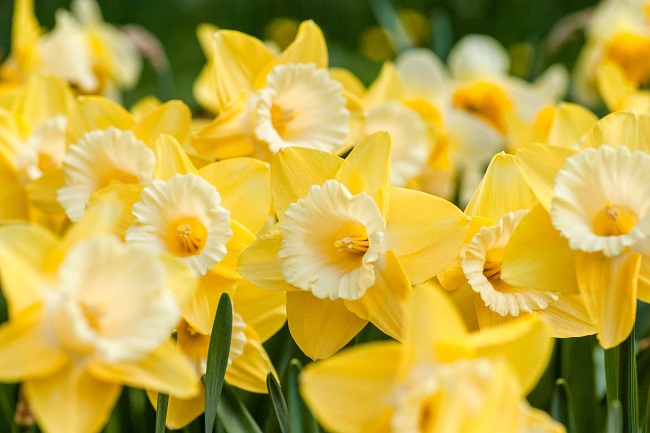
With their vibrant hues and cheerful presence, daffodils herald the arrival of spring, injecting a burst of color into any landscape. These iconic flowers, also known as narcissus, are renowned for their versatility, ease of cultivation, and ability to thrive in a variety of conditions. In this article, we will explore the best ways to use daffodils in your yard and garden, as well as provide valuable tips on growing these enchanting blooms.
Daffodils in Yard and Garden Settings
Daffodils are incredibly versatile and can enhance your outdoor spaces in numerous ways. Here are some of the best ways to incorporate them into your yard and garden:
Mass Plantings
Create breathtaking displays by planting daffodils in large clusters. Whether in a designated daffodil bed or scattered throughout your garden, mass plantings of daffodils create a visual spectacle that is hard to ignore.
Borders and Edges
Use daffodils to edge pathways, borders, or garden beds. Their bright blooms will provide a striking contrast against the surrounding greenery and help define the boundaries of your garden.
Naturalized Areas
Daffodils are excellent for naturalizing. Plant them in drifts or clusters in open spaces, meadows, or wooded areas to create a captivating natural carpet of spring flowers.
Container Gardens
Daffodils can also be grown in containers, allowing you to enjoy their beauty on patios, balconies, or even indoors. Choose smaller varieties that are well-suited for container gardening.
How to Grow Daffodils
Growing daffodils is a rewarding and straightforward endeavor. Follow these steps to ensure successful cultivation:
Choosing Bulbs
Select healthy, firm bulbs from reputable sources. Consider the desired flower color, height, and bloom time when choosing varieties. Daffodils come in a wide range of shapes, sizes, and colors, including yellow, white, pink, and even bicolor.
Soil Preparation
Daffodils prefer well-draining soil rich in organic matter. Before planting, loosen the soil and remove any weeds or debris. Incorporate compost or well-rotted manure to improve soil fertility.
Planting Depth and Spacing
Dig holes that are 6-8 inches deep. Place bulbs with the pointed end up and space them 4-6 inches apart. If planting in groups, leave enough space between clusters for the plants to spread naturally.
Sunlight and Watering
Daffodils thrive in full to partial sunlight. Ensure they receive at least 6 hours of direct sunlight per day. Water thoroughly after planting and provide regular watering during dry spells, especially in the early stages of growth.
Care and Maintenance
Daffodils are generally low-maintenance plants. Remove spent blooms to divert energy into bulb development. After blooming, allow the foliage to wither naturally before trimming it back. This helps the bulbs store energy for the next season.
Additional Information
For further information on daffodils, consider visiting The American Daffodil Society or the Royal Horticultural Society. These resources offer comprehensive information on daffodil varieties, cultivation techniques, troubleshooting tips, and inspiring ideas for incorporating daffodils into your garden.
Conclusion
Daffodils are a delightful addition to any yard or garden, providing a vivid display of color and heralding the arrival of spring. Whether in mass plantings, borders, naturalized areas, or containers, their radiant blooms bring joy and beauty to outdoor spaces. By following the simple guidelines for growing daffodils, you can enjoy these enchanting flowers year after year. So, get ready to embrace the charm of daffodils and create a vibrant and welcoming landscape.
10 Fun Facts About Daffodils
Symbol of Renewal
Daffodils are often regarded as a symbol of renewal and new beginnings. Their appearance in early spring represents the end of winter and the arrival of brighter days.
Ancient History
Daffodils have a long and storied history. They were cultivated by ancient civilizations such as the Greeks and Romans, who believed they had medicinal properties and used them in herbal remedies.
Birth Flower of March
Daffodils are the birth flower for the month of March. They are associated with qualities like creativity, inspiration, and resilience, making them a fitting symbol for individuals born in this month.
Toxic to Other Flowers
Daffodils produce a substance called lycorine, which can be toxic to other cut flowers. When arranging daffodils with other flowers, it’s best to soak them separately for 24 hours before combining them to reduce the risk of wilting or damage to the other blooms.
A Variety of Colors
While yellow is the most common color associated with daffodils, they come in a wide range of hues. You can find daffodils in shades of white, orange, pink, peach, and even green.
Long-lasting Blooms
Daffodil flowers have an impressive longevity compared to many other spring blooms. Under the right conditions, they can last up to two weeks in a vase, bringing cheer and beauty to indoor spaces.
Deer and Rodent Resistant
Daffodils contain toxic alkaloids that make them unappealing to deer, rabbits, and rodents. This natural deterrent makes daffodils an excellent choice for gardens plagued by these pests.
Naturalized Wonders
Daffodils are well-suited for naturalizing, meaning they can thrive and multiply in the wild. Over time, they can form large colonies, creating stunning displays in meadows, woodland areas, and along roadsides.
Hardy Bulbs
Daffodil bulbs are exceptionally hardy and can survive harsh winter conditions. They are often among the first flowers to bloom in the spring, emerging even through late snowfalls.
Wordsworth’s Poetic Connection
Daffodils hold a special place in literature and poetry. The famous poet William Wordsworth wrote the renowned poem “I Wandered Lonely as a Cloud” (also known as “Daffodils”), inspired by the sight of daffodils dancing in the breeze.
Related Articles & Free Email Newsletter Sign Up
Flowering Maple is a Versatile Landscape or Houseplant
Quick and Easy Ways to Divide Perennial Plants




Comment here